|
St. Louis
Car Company During World War Two
St. Louis, MO
1887-1974
This page added
3-12-2022.
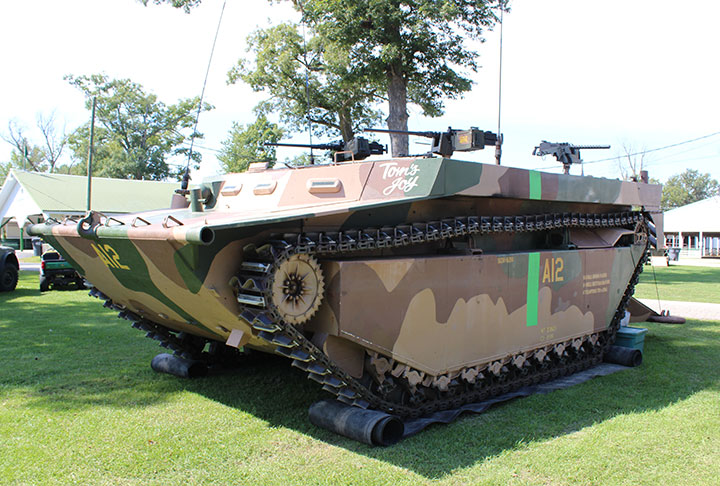
This LVT-4 was built by the St. Louis Car Company in 1945. It is
the only known existing LVT-4 that has been identified as to which
company manufactured it. Author's photo.
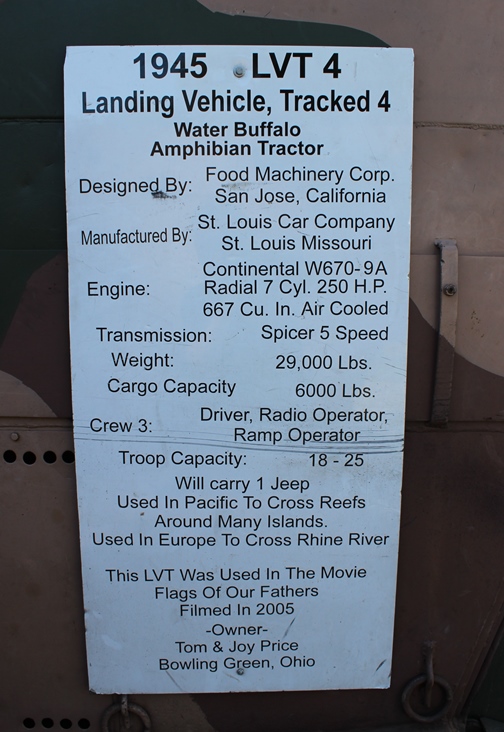
This is the information board that is displayed with the LVT-4 showing
that it was built by the St. Louis Car Company. Author's photo.
The St. Louis Car Company was formed in 1887 to manufacture streetcars
and other rolling stock for the rail industry. During its long
life it also made automobiles, railroad cars, locomotives, and trolley
buses. Its last products before closing were subway cars for New
York City. It also manufactured the passenger capsules that are
used in the St. Louis Arch. I have ridden on one of these along
with my family when we visited the Arch.
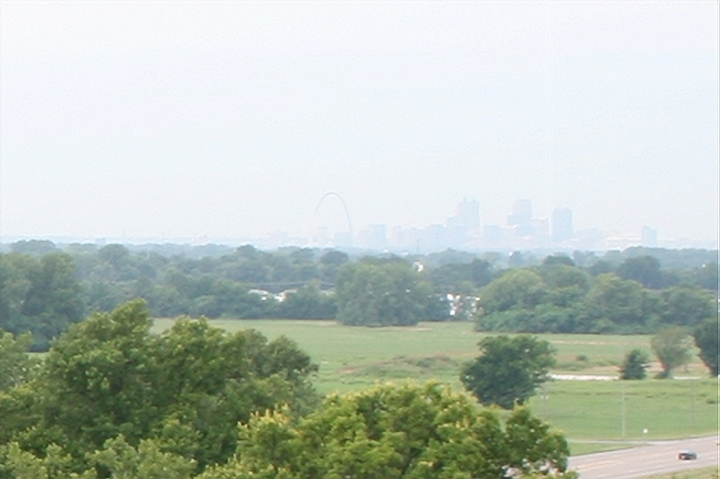
Even on an overcast morning, the St. Louis
Arch with its St. Louis Car Company-built passenger capsules can be seen
from the Great Mound at Cahokia, IL. Author's photo.
St. Louis Car Company World War Two Products: Table 1 shows
that the St. Louis Car Company had three major products during World War
Two. They were ammunition cars, landing craft, and electric
generators. Tracked amphibious landing craft was the largest
portion of the company's business during World War Two with $54,470,000
or 79.4% of the total. Generator sets of various types at
$13,378,000 or 19.5% of the total amount contracted was second.
Ammunition cars, which was the company's first major contract that was
awarded in August 1941 was for $745,00 or 1%.
Many of the streetcars and
other rail equipment the company made before and after World War Two
were electrically powered. The manufacture of generator sets for
the war effort was a good fit for this company.
Table 1 - St. Louis Car
Company's Major World War Two Contracts
The information below
comes from the "Alphabetical Listing of Major War Supply
Contracts, June 1940 through September 1945." This was
published by the Civilian Production Administration,
Industrial Statistics Division. |
|
Product |
Contract Amount |
Contract Awarded
|
Completion
Date |
Contract Number |
|
Cars Ammunition |
$745,000 |
8-1941 |
6-1942 |
|
|
Landing Craft |
$2,682,000 |
1-1942 |
10-1942 |
Nos 97599 |
|
Electric Generators |
$781,000 |
8-1942 |
9-1943 |
|
|
Generators |
$641,000 |
9-1942 |
4-1943 |
|
|
Generating Plants |
$3,772,000 |
9-1942 |
9-1943 |
|
|
Landing Craft LVT |
$12,676,000 |
12-1942 |
12-1943 |
NObs 858 |
|
Diesel Generator Units |
$5,807,000 |
11-1943 |
8-1944 |
|
|
Landing Vehicles LVT |
$17,775,000 |
1-1944 |
4-1945 |
NObs 1469 |
|
Landing Vehicles. LVT |
$13,695,000 |
4-1944 |
8-1944 |
NObs 8588 |
|
Landing Vehicles. LVT |
$7,642,000 |
6-1944 |
8-1945 |
NObs 1789 |
|
Diesel Generator Stations |
$2,377,000 |
3-1945 |
10-1945 |
|
|
Total |
$68,593,000 |
|
|
|
St. Louis Car Company built Landing
Vehicles, Tracked (LVT) of several types during World War Two.
Using Tables 1, 3, and 4, it can be determined in some cases how many of each type the
company built.
Contract Nos 97599: Table 1
shows contract number Nos 97599 for landing craft that were built
between January and October 1942. Table 3 shows that the LVT-1 was
the only vehicle of this type built in 1942, indicating that contract
Nos 97599 was for the LVT-1. Table 4 shows that
the average cost of a St. Louis Car Company-built LVT-4
was between $22,000 and $24,050. Using a value of $23,000 for the
cost of an LVT-1 and dividing that into the $2,682,000 for contract Nos
97599 results in 116. Therefore, for the first LVT contract, the
company built approximately 116 LVT-1s. This result is displayed
in Table 2.
Contract NObs 858: The next
contract for landing craft is contract number NObs 858 that was issued
in December 1942 and completed in December 1943. Again, using the
average of $23,000 cost per unit and dividing that into the contracted
amount of $12,676,000 gives a value of 551 units. Table 3 shows
that there were several types of LVTs built in 1943. However, only
the LVT-2 was built in a large enough volume to include the estimated
551 units for which St. Louis Car was contracted. This result is
displayed in Table 2.
Contract NObs 1469: This
contract was for the LVT-4. Using information from Table 4 and
adding 497 and 293 results in 790 total units for this contract.
Dividing 790 into the $17,775,000 total contracted cost gives an average
cost per unit of $22,500, which agrees with one of the two values for
average cost shown for this contract in Table 4. Information from
Table 1 and Table 4 agree.
Contract NObs 8588: For this
contract listed in Table 1, there is not an associated contract number
listed in Table 4. Dividing $23,000 estimated average cost per
unit into the contract value of $13,695,000 yields 795 units. Not
being listed in Table 4 indicates this may have been something other than an
LVT-4. There were several other types of LVTs that were built in
1944. However, St. Louis Car Company did not build the LVT-3, which
leaves the LVT-2 or LVT(A)-4. Within the short period of five months
from contract release until completion, it is most likely that this was an expedited
build of the LVT(A)-4, which was an armed version of the LVT-4 and
needed to provide short range artillery fire support for the landing
forces. With the short time frame involved and the addition of an
armored turret, the average cost would no doubt be more than $23,000.
Therefore, using a higher estimated cost of $30,000 for the units
results in 456 units.
Until further information is found, this
value will be used. This is one of the hazards of trying to
determine what was produced 80 years ago with limited information. It is not uncommon to find
conflicting and confounding information.
Contract NObs 1789: Table 4
shows that there were 518 units in this contract. However, when
one divides 518 into the amount of the contract,
$7,642,000, the resulting cost per unit is $14,753, not the
$22,000 per unit as shown in Table 4.
I will use the 518 as the number of units
built and ignore the cost issue.
|
Table 2 - Estimated Number of
LVTs of all types built by the St. Louis Car Company |
|
Type LVT |
Number Built |
Source |
Contract |
|
LVT-1 |
116 |
Estimated from Tables 1 and 3. |
Nos 97599 |
|
LVT-2 |
551 |
Estimated from Tables 1 and 3. |
NObs 858 |
|
LVT-4 |
790 |
From Tables 1 and 4.
|
NObs 1469 |
|
LVT(A)-4 ? |
456? |
Estimated |
NObs 8588 |
|
LVT-4 |
518 |
From Table 4 |
NObs 1789 |
|
Total |
2,431 |
This is an estimate. |
|
Table 3 - World War Two LVT Production
From "Amtrack: US Amphibious Assault Vehicles by
Steven Zaloga published 1987 |
|
Type |
1941 |
1942 |
1943 |
1944 |
1945 |
Total |
|
LVT-1 |
72 |
851 |
302 |
|
|
1,225 |
|
LVT(A)-1 |
|
3 |
288 |
219 |
|
510 |
|
LVT-2 |
|
|
1,540 |
1,422 |
|
2,962 |
|
LVT(A)-2 |
|
|
200 |
250 |
|
450 |
|
LVT-3 |
|
|
1 |
733 |
2,230 |
2,964 |
|
LVT-4 |
|
|
11 |
4,980 |
3,360 |
8,351 |
|
LVT(A)-4 |
|
|
|
1,489 |
401 |
1,890 |
|
LVT(A)-5 |
|
|
|
|
269 |
269 |
|
Totals |
72 |
854 |
2,342 |
9,093 |
6,260 |
18,621 |
Table 4 - St. Louis Car Company LVT-4 Contracted Production
Information from "LVT(4) Amtrac - The Most Widely Used
Amphibious Tractor of World War II" by David Doyle |
|
Number Contracted |
U.S. Navy Hull Numbers |
U.S. Navy Contract Number
|
Cost per LVT-4 |
| 497 |
C-58855 - C-59351 |
NObs 1469 |
$22,500 |
| 293 |
C-63790 - C-64082 |
NObs 1469 |
$24,050 |
| 390 |
C-88869 - C-89258 |
NObs 1789 |
$22,000 |
| 518 |
C-90707 - C-91224 |
NObs 1789 |
$22,000 |
| 1,698 |
Total |
|
|
Table 5 - Total LVT-4 Contracted Production
Information from "LVT(4) Amtrac - The Most Widely Used
Amphibious Tractor of World War II" by David Doyle published
2020 |
|
Company |
Number Contracted |
Percentage |
|
FMC Riverside, CA |
1,876 |
19.4% |
|
FMC San Jose, CA |
3,451 |
35.6% |
|
FMC Lakeland, Lakeland, CA |
1,825 |
18.9% |
|
FMC Sub-Total |
7,152 |
74% |
|
St. Louis Car Company |
1,698 |
17.6% |
|
Graham-Paige |
757 |
7.8% |
|
Unknown |
60 |
.62% |
|
Total |
9,667 |
100% |
|
Cancelled LVT-4s in August 1945 |
1,838 |
|
|
Total Production |
7,829 |
|
St. Louis Car Company was contracted
to build 1,698 out of 9,667 LVT-4s during World War Two. With
the termination of hostilities in August 1945, 1,300 units were
cancelled among the four companies building the LVT-4. It is
unknown how many of the 1,698 LVT-4s St. Louis Car was contracted
for were
actually built and accepted by the U.S. Navy.
While the U.S. Navy was the military
organization that contracted for the LVT-4, 74% were transferred to
the U.S. Army., who used most of them in Europe
for river crossings, many of them under fire.
The following table shows
the increased use of LVTs as they became more available during the U.S.
Navy's World War Two campaign in the Central Pacific. LVTs
were utilized at Guadalcanal for the transport of supplies to the
island, not in the initial assault waves. As the war continued the
LVTs became very important where the islands had coral atolls that
prevented the 36-foot wooden landing craft such as the LCP(L)s, LCVs,
LCP(R)s and LCVPs from crossing. Even with their low draft, the
landing craft would get hung up on the atolls. The LVTs with their
tracks could cross over the reef. A shuttle system was instituted
where the wooden landing craft would bring marines and soldiers from the
troop transports to the atoll. There, the marines and soldiers
would transfer to the LVTs, which would then take them to the beach.
Transfer of the troops at the reef called for previous training by all
involved to safely and efficiently make the troop transfer. Add a
heavy surf and it became an even more dangerous endeavor than normal.
Neither Iwo Jima nor Okinawa had reefs, but by the end of the war the LVT had become an important part of the landing assault forces.
|
Table 6 -
Number of LVTs and LVT(A)s used in the Assault Waves during the
Central Pacific Campaign
The first LVT(A)s were armed with 37mm cannons and the later
ones with 75mm howitzers. These provided close-in fire
support for the LVTs as they made their run-in to the beach.
It is unknown whether Graham-Paige made this type vehicle. |
|
Island |
Date |
LVT |
LVT(A) |
|
Guadalcanal |
8-1942 |
0 |
0 |
|
Tarawa |
11-1943 |
87 |
0 |
|
Saipan |
6-1944 |
594 |
138 |
| Guam |
7-1944 |
381 |
75 |
|
Tinian |
7-1944 |
453 |
66 |
|
Peleliu |
9-1944 |
223 |
72 |
| Iwo
Jima |
2-1945 |
380 |
68 |
|
Okinawa |
4-1945 |
872 |
92 |
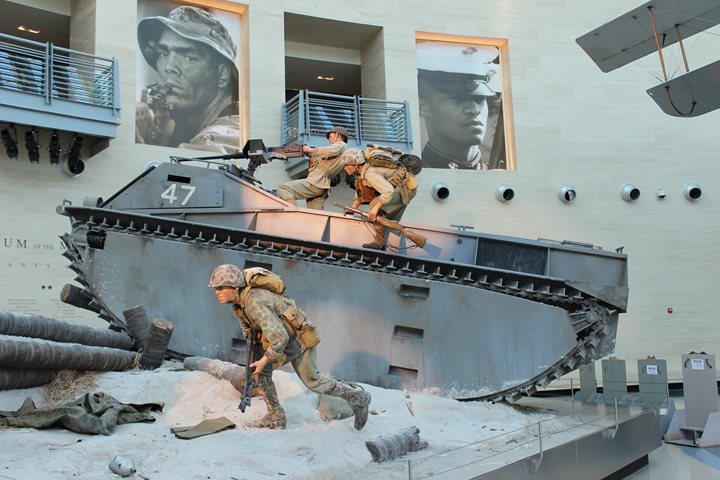
St. Louis Car Company built an
estimated 116 LVT-1's in 1942. This diorama at the National Museum
of the USMC depicts an LVT-1 going over a log barricade at Tarawa.
Author's photo.
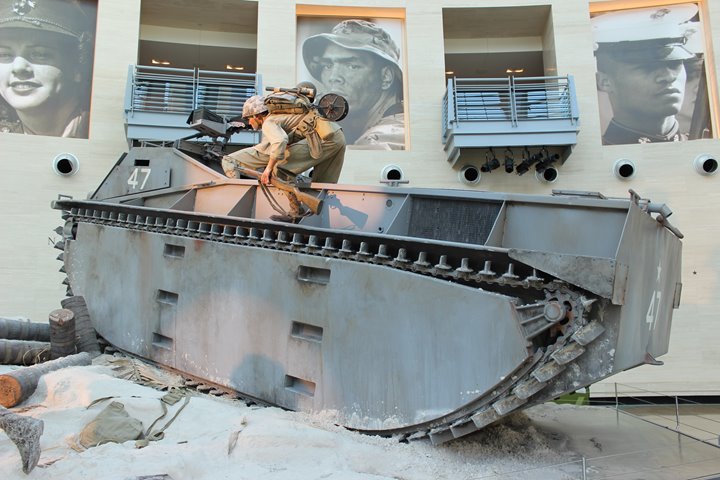
This and the following photo show that the rear is a solid piece with no
ramp. The Marines had to go over the side as shown here and jump
down eight feet to the sand. Author's photo.
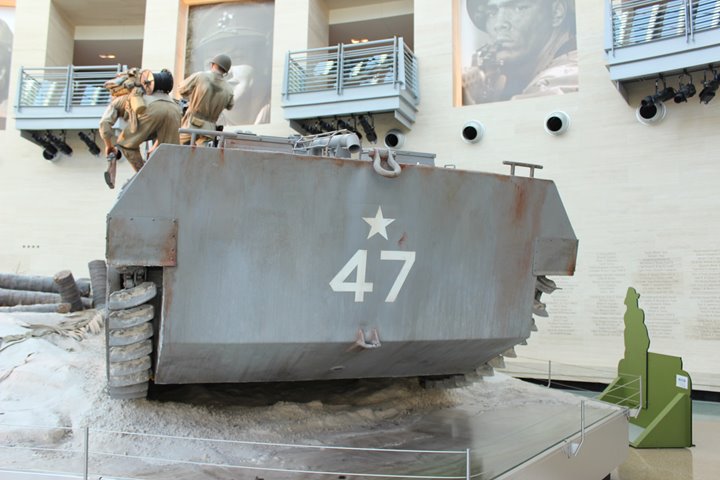
Author's photo.
Below are more photos of the St.
Louis Car Company-built LVT-4.
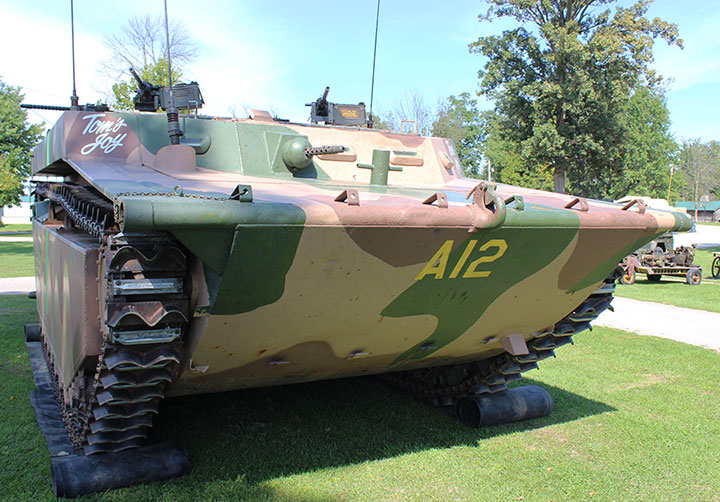
Note the internal and external armament. Author's photo
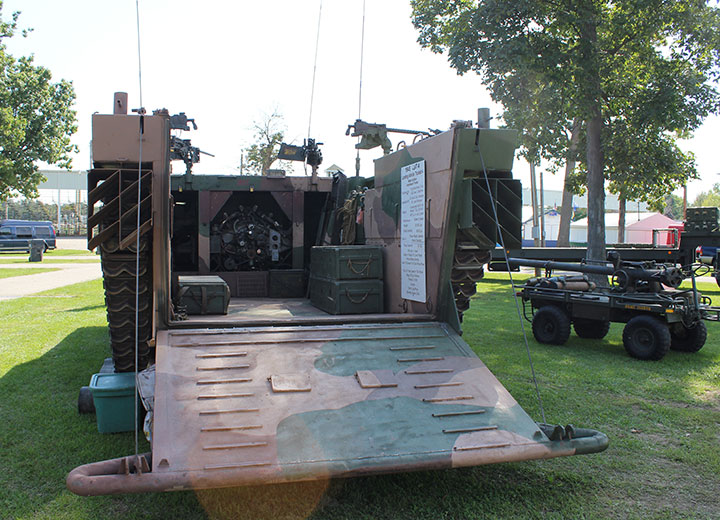
The LVT-4 was the first in the series to
have a ramp. On the LVT-1 and 2, the soldiers and marines had to
make an eight foot jump over the side to get out, and small
vehicles could not be carried without the ramp. Author's photo.
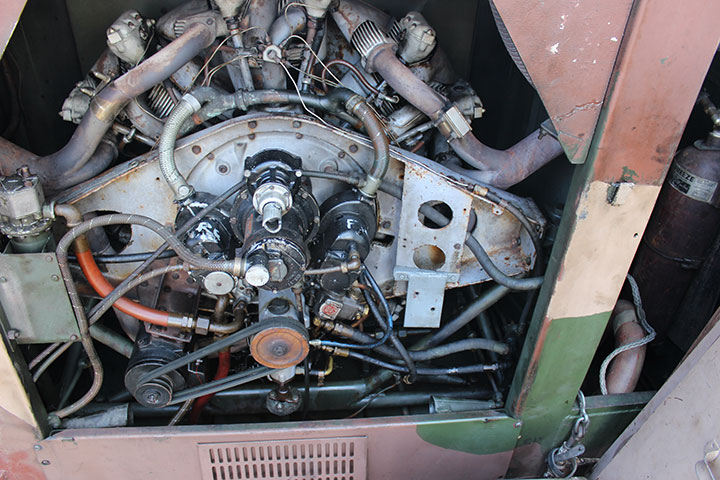
The LVT-4 was powered by a Continental
R-670-9A seven cylinder radial aircraft engine producing 250 hp.
The radial engines, being originally designed to operate at relatively
constant speeds for aircraft, did not work out well when having to
constantly change RPMs when being shifted through the five speeds of the
Spicer transmission. Author's photo.
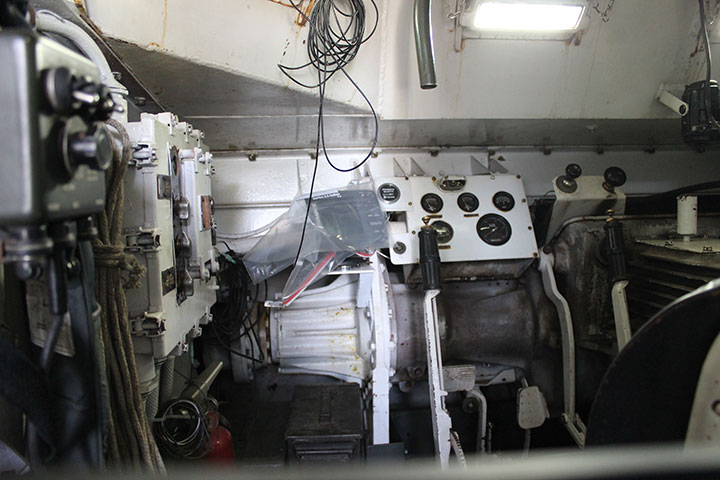
The driver's station with the Spicer transmission just visible to the
right and the powered axle in front of the controls and instrument
panel. Author's photo.
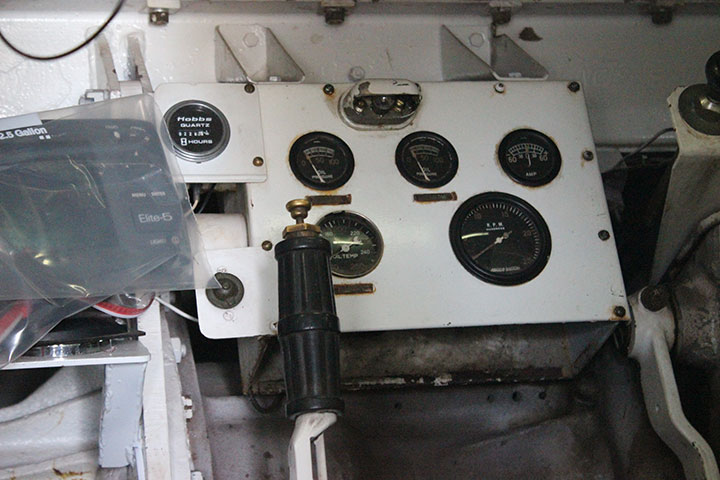
The instrument panel inside the LVT-4.
Author's photo.
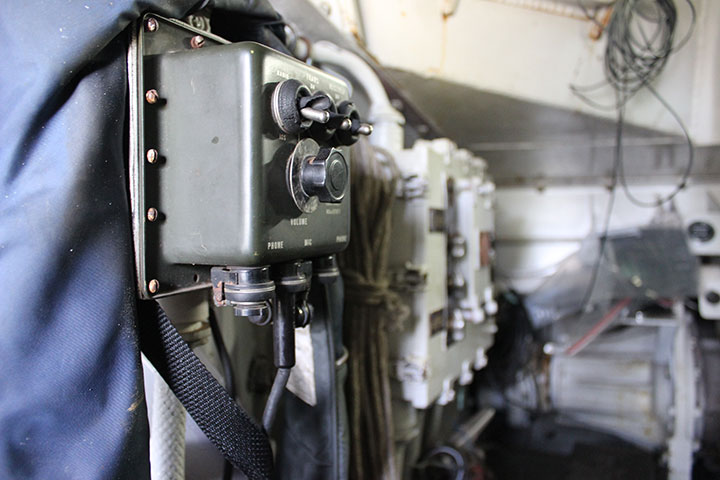
The radio control box is at the left.
Author's photo.
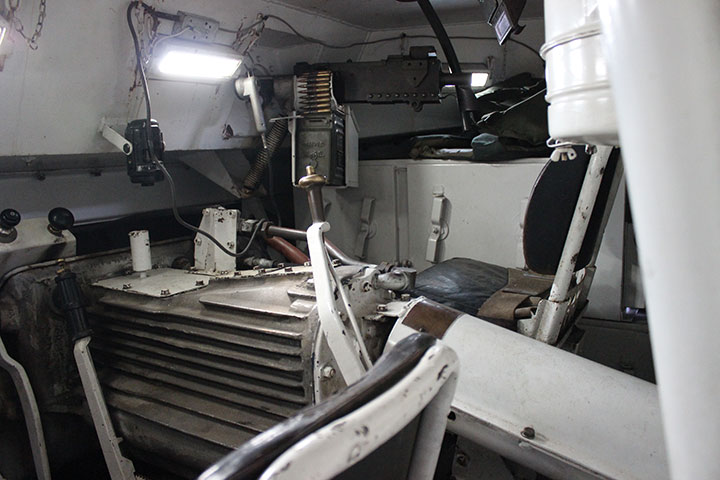
The gunner's position with the .30 caliber
machine gun. One can see the transmission better in this photo
and the covering over the driveshaft from the engine. Author's
photo.
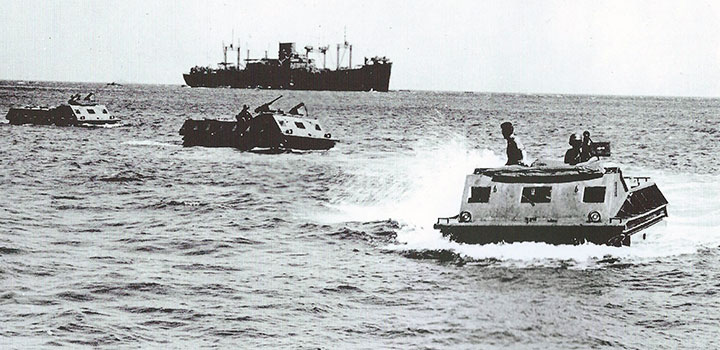
The first use of the LVT was at the landings
at Guadalcanal on August 7, 1942, where they were used to bring supplies
ashore. St. Louis Car Company-built LVT-1 could be among those
pictured here.
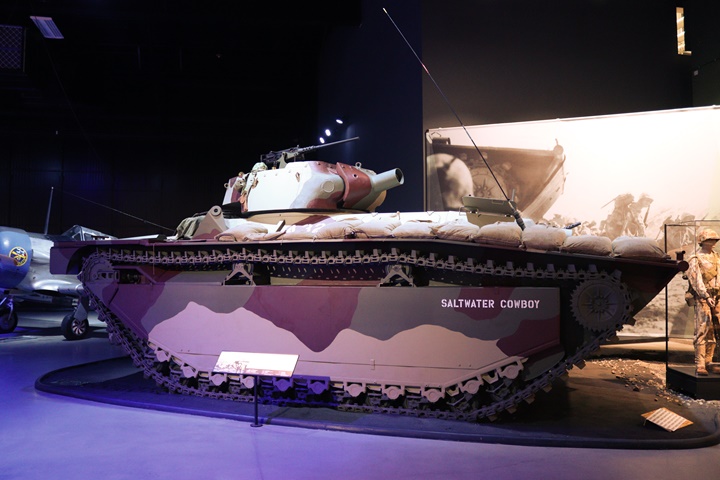
This LVT-(A)4, which is armed with a 75mm
howitzer, is on display at the American Heritage Museum in Hudson, MA.
My research above indicates that St. Louis Car could have built LVT-(A)-4s
like this one. Author's photo
|














